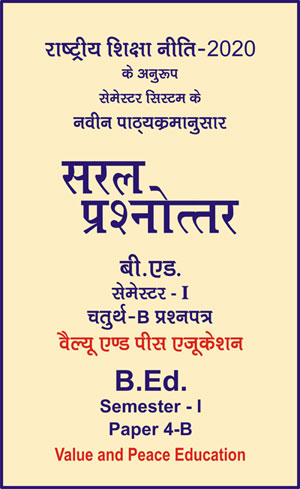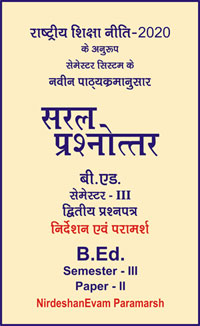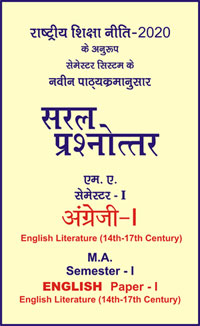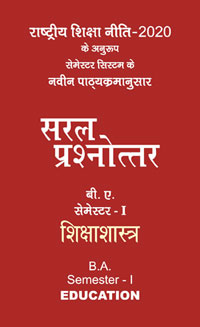|
बी एड - एम एड >> बी.एड. सेमेस्टर-1 प्रश्नपत्र-IV-B - वैल्यू एण्ड पीस एजुकेशन बी.एड. सेमेस्टर-1 प्रश्नपत्र-IV-B - वैल्यू एण्ड पीस एजुकेशनसरल प्रश्नोत्तर समूह
|
|
||||||
बी.एड. सेमेस्टर-1 प्रश्नपत्र-IV-B - वैल्यू एण्ड पीस एजुकेशन (अंग्रेजी भाषा में)
Neutralization of Anger
- Which of the following IS TRUE regarding the meaning of the word angst?
(a) the word carries the same meaning in both the English and German languages
(b) to English speakers, angst means an extreme state of anxiety experienced because of social isolation and loneliness
(c) to German speakers, angst is equivalent to the term dread
(d) to German speakers, angst is a state of being with no known causes
-
When German speakers are having a difficult day "keeping it together", they would use which of the following words to describe this experience?
(a) fear
(b) anxiety
(c) angst
(d) sadness -
Which of the following individuals connects to the term 'emotional intelligence'?
(a) Goleman
(b) Weschler
(c) Sternberg
(d) Ekman -
Ricky is assessed as having high emotional intelligence. This means he has:
(a) skills and abilities that help him understand people from another cultural heritage
(b) skills and abilities that help him process, understand, and regulate his emotions and those of others
(c) skills that help them problem solve
(d) skills and abilities that help them to acquire language -
Which of the following IS NOT a skill associated with emotional intelligence?
(a) experiencing love
(b) negotiating conflict
(c) being sensitive to others
(d) expressing pride and anger -
Emotions are:
(a) objective responses to experiences in our environment
(b) subjective responses to experiences in our environment
(c) physiological changes to experiences in our environment
(d) behavioral changes to experiences in our environment -
Which of the following statements aligned with the James-Lang theory of emotion?
(a) emotions are objective responses to experiences in our environment
(b) emotional experiences are dependent upon physiological responses
(c) emotional experiences are dependent upon physiological responses and how a person interprets those responses
(d) emotions are the result of an individual's emotional intelligence -
The James-Lang theory of emotion would predict that:
(a) if your blood pressure rises and you get red in the face you should experience anger
(b) if your blood pressure rises and you get red in the face should experience happiness
(c) if your blood pressure rises and you interpret this behavior positively you will experience happiness -
Which of the following statements aligned with the Two Factor theory of emotion?
(a) emotions are objective responses to experiences in our environment
(b) emotional experiences are dependent upon physiological responses
(c) emotional experiences are dependent upon physiological responses and how a person interprets those responses
(d) emotions are the result of an individual's emotional intelligence -
The Two Factor Theory of emotions would predict that:
(a) emotional responses are universal
(b) if your heartbeats rapidly because you have to speak in public, you will experience fear
(c) situational and contextual factors shape our interpretations of our emotional experience
(d) cognitive interpretation has no place in emotional experience -
The term emoting refers to:
(a) emotional intelligence
(b) the universal experience of emotion
(c) the cultural specific experience of emotion
(d) the embeddedness of emotions and social relationships -
The phrase "acting in context" connects to which of the following concepts?
(a) emotional intelligence
(b) the James-Lange theory of emotions
(c) emoting
(d) the Two Factor theory of emotions -
Which of the following is an example of emoting in infancy?
(a) an infant smiles at a caregiver and the caregiver continues playing with the infant
(b) a newborn cries because he or she is tired
(c) newborn laughs at a social stimulus
(d) a caregiver feeds an infant who is hungry -
In early childhood, children learn about their emotions through all of the following EXCEPT:
(a) observing adults
(b) conversations with adult partners
(c) child rearing practices
(d) their intuitive thinking about the world -
All of the following shape emoting EXCEPT:
(a) gender roles
(b) culture
(c) power
(d) language -
In societies that value the connectedness of individuals, shame is an emotional response that encourages the development of all of the following EXCEPT:
(a) failure
(b) humility
(c) obedience
(d) interdependency -
Mesquita's view of emoting parallels which of the following views?
(a) emotions are subjective responses
(b) emotions are objective responses
(c) culture in mind
(d) culture and mind mutually constitute one another -
Among the Tamang, shame connects to:
(a) humility
(b) anger
(c) dominance
(d) weakness -
The same emotion may not have the same function or meaning in different cultural communities. Among the Brahmans, shame connects to:
(a) humility
(b) anger
(c) dominance
(d) weakness
|
|||||

 i
i 









